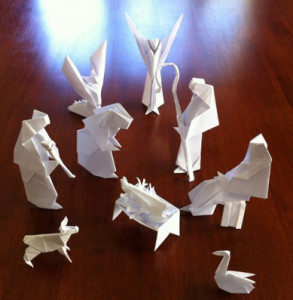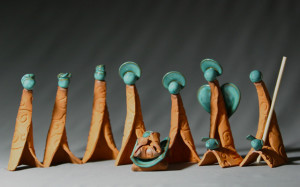Everything about being in Spain was so new and different for me, that it’s no wonder that Christmas was too. I grew up with Santa, Christmas trees and stockings hanging over the fireplace, and naively thought these were universal. Not so. Santa only recently got exported to Spain and is still not very popular. Traditionally, gifts are exchanged on January 6th, the Three Kings Day. Christmas trees were also rare, small and frankly, not that pretty. Most houses did not have one. But nativity scenes, or Belenes de Navidad, (Belen is the Spanish word for Bethlehem) were very common Christmas decorations and they were–and still are, amazing. Most of the nativity scenes I’d ever known in the US consisted of the nuclear family, some barnyard animals and maybe a few shepherds or the magi. So, altogether, 10 figures on average, and maybe the larger ones had 20 or so. But the ones in Spain are extensive and elaborate, and can sometimes include hundreds of little characters depicting not just the nativity scene in the barn, but the entire village and sometimes the neighboring villages as well. Every time I saw one in a shop or storefront I wanted to stand and stare for hours, admiring the artisanal labor.
As a matter of fact, there were often contests between different shops, and people would go from one store front to the next judging them. And it was not uncommon to hear people in cafe’s and on the street discussing which ones they liked better. Belenes were in all of the houses too. You would rarely ever see a Christmas tree or stockings hanging, but everyone’s house, religious or not, had a Belen.
So, exactly how old is the custom of recreating the nativity scene? I was surprised that it was not as ancient as I would have thought. According to Wikipedia, the first one was done by St. Francis of Asissi in 1223 in a cave close to a tiny church in Italy. He didn’t use statues or even real people, just a small empty cradle, an ox and a mule, to illustrate the humble circumstances of the birth. St. Francis sang a captivating hymn and told the story with such passion that the owner of the cave, Juan de Greccio, later assured everyone that he had actually seen the Christ child in the cradle and that St. Francis had picked up the baby and rocked him to sleep in his arms. After this first nativity scene, it appears that re-enactments were slowly incorporated into liturgical drama. In the next hundred years, the Franciscan monks, who were among the poorest group of monks as they took vows of poverty, continued to represent this humble picture of the nativity scene and it gradually spread from the Italian peninsula to all of Europe.
Nowadays it’s not just stores and homes with nativity scenes on display—entire cities get involved. As a matter of fact, this year, Bilbao, on the northern coast of Spain (and where parts of my novels are set) is having a contest, hosting 40 of the best Belenes from all over Europe. This video is an interview with one of the men hosting the contest, and it shows some fine-looking nativity scenes they began making back in April. He also acknowledges that Belenes are not just for the religious, but are part of the Spanish culture and tradition.
There are many blogs about Belenes, and one in particular caught my attention: Decofilia.com has some gorgeous photos of creative nativity scenes made from all manner of materials. There’s even one made from wrenches! I wrote to them and asked if I could use some of their pictures for my blog, and they graciously agreed and wished me well. Such nice people!
Google, of course, also has some great photos of intricate nativity scenes.
I hope you’ll take a look at some of these links, and if you ever get the chance to be in Spain in December, I hope you’ll take some time to go admire their glorious Belenes.

I love origami and thus was particularly intrigued by this one! Thanks again to the nice people at Decofilia.com for allowing me to use their image!
If you enjoyed this blog post, you might also like my series of novels, Bueno, Sinco and Brujas, which takes place in Santander, Spain.



